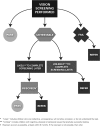Vision screening for children 36 to <72 months: recommended practices
- PMID: 25562476
- PMCID: PMC4274336
- DOI: 10.1097/OPX.0000000000000429
Vision screening for children 36 to <72 months: recommended practices
Abstract
Purpose: This article provides recommendations for screening children aged 36 to younger than 72 months for eye and visual system disorders. The recommendations were developed by the National Expert Panel to the National Center for Children's Vision and Eye Health, sponsored by Prevent Blindness, and funded by the Maternal and Child Health Bureau of the Health Resources and Services Administration, United States Department of Health and Human Services. The recommendations describe both best and acceptable practice standards. Targeted vision disorders for screening are primarily amblyopia, strabismus, significant refractive error, and associated risk factors. The recommended screening tests are intended for use by lay screeners, nurses, and other personnel who screen children in educational, community, public health, or primary health care settings. Characteristics of children who should be examined by an optometrist or ophthalmologist rather than undergo vision screening are also described.
Results: There are two current best practice vision screening methods for children aged 36 to younger than 72 months: (1) monocular visual acuity testing using single HOTV letters or LEA Symbols surrounded by crowding bars at a 5-ft (1.5 m) test distance, with the child responding by either matching or naming, or (2) instrument-based testing using the Retinomax autorefractor or the SureSight Vision Screener with the Vision in Preschoolers Study data software installed (version 2.24 or 2.25 set to minus cylinder form). Using the Plusoptix Photoscreener is acceptable practice, as is adding stereoacuity testing using the PASS (Preschool Assessment of Stereopsis with a Smile) stereotest as a supplemental procedure to visual acuity testing or autorefraction.
Conclusions: The National Expert Panel recommends that children aged 36 to younger than 72 months be screened annually (best practice) or at least once (accepted minimum standard) using one of the best practice approaches. Technological updates will be maintained at http://nationalcenter.preventblindness.org.
Figures
References
-
- Tarczy-Hornoch K, Varma R, Cotter SA, McKean-Cowdin R, Lin JH, Borchert MS, Torres M, Wen G, Azen SP, Tielsch JM, Friedman DS, Repka MX, Katz J, Ibironke J, Giordano L. Risk factors for decreased visual acuity in preschool children: the multi-ethnic pediatric eye disease and Baltimore pediatric eye disease studies. Ophthalmology 2011; 118: 2262– 73. - PMC - PubMed
-
- United States Preventive Services Task Force. Vision screening for children 1 to 5 years of age: US Preventive Services Task Force Recommendation statement. Pediatrics 2011; 127: 340– 6. - PubMed
Publication types
MeSH terms
Grants and funding
LinkOut - more resources
Full Text Sources
Medical


